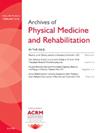建立经股骨锚定肢体假体成分处方共识:一项国际德尔菲法研究。
IF 3.7
2区 医学
Q1 REHABILITATION
Archives of physical medicine and rehabilitation
Pub Date : 2025-10-01
DOI:10.1016/j.apmr.2025.06.011
引用次数: 0
摘要
目的:为了指导骨锚定肢体(bone-anchor limbs, BALs)患者的假体组份处方,我们采用Delphi法建立了国际上第一个关于经股骨锚定肢体假体组份选择的共识。设计:在2023年11月至2024年9月期间进行三轮德尔菲研究。背景:向美国、瑞典、荷兰、澳大利亚和加拿大的代表分发匿名数字调查。参与者:18位全球义肢护理领域的临床专家作为代表参加。干预措施:不适用。主要成果衡量标准:主题声明共识定义为代表至少80%的同意。结果:48个主题声明中有34个与BALs患者的单个假体部件和处方有关,达成了普遍一致的共识。人们强烈同意,假体处方不应根据性别或年龄而改变,而应根据患者的身体能力和期望的功能活动而改变。达成的共识与当前下肢窝式假体的临床实践指南一致,例如使用微处理器膝关节。其他研究结果强调了专家们不确定的领域,例如假体安全硬件是否应该在冠状面或矢状面保护种植体和骨骼免受高负荷的影响。结论:本文确定的主题可以作为进一步证据的创建来指导临床医生选择假体组件,以提高bal患者的安全性和功能预后。这一共识为构建未来临床实践指南和确定未来研究的知识差距提供了基础。本文章由计算机程序翻译,如有差异,请以英文原文为准。
Establishing Consensus for Prescription of Prosthetic Components for Transfemoral Bone-Anchored Limbs: An International Delphi Method Study
Objective
To guide prosthetic componentry prescription for patients with bone-anchored limbs (BALs), we established the first international consensus on prosthetic component selection for transfemoral BALs using the Delphi method.
Design
Three-round Delphi study taking place between November 2023 and September 2024.
Setting
Anonymous digital surveys were distributed to delegates in the United States, Sweden, the Netherlands, Australia, and Canada.
Participants
Eighteen (N=18) worldwide clinical experts in prosthetic care for patients with BAL participated as delegates.
Interventions
None.
Main Outcome Measures
Thematic statement consensus was defined as delegate agreement of at least 80%.
Results
Thirty-four out of 48 thematic statements pertaining to individual prosthetic components and prescriptions for patients with BALs achieved general agreement consensus. There was strong agreement that prosthesis prescription should not change on the basis of sex or age, but rather on the physical ability and desired functional activities of the patient. The consensus reached aligns with current clinical practice guidelines for lower limb socket prostheses, such as the use of microprocessor knees. Other findings highlighted areas of uncertainty among experts, such as whether the implant and bone should be protected against high loads in the coronal or sagittal planes with prosthetic safety hardware.
Conclusions
The themes identified here can serve to guide clinicians in the selection of prosthetic components as further evidence is created to promote safety and functional outcomes for individuals with BALs. This consensus provides a basis for structuring future clinical practice guidelines and identifying knowledge gaps for future research studies.
求助全文
通过发布文献求助,成功后即可免费获取论文全文。
去求助
来源期刊
CiteScore
6.20
自引率
4.70%
发文量
495
审稿时长
38 days
期刊介绍:
The Archives of Physical Medicine and Rehabilitation publishes original, peer-reviewed research and clinical reports on important trends and developments in physical medicine and rehabilitation and related fields. This international journal brings researchers and clinicians authoritative information on the therapeutic utilization of physical, behavioral and pharmaceutical agents in providing comprehensive care for individuals with chronic illness and disabilities.
Archives began publication in 1920, publishes monthly, and is the official journal of the American Congress of Rehabilitation Medicine. Its papers are cited more often than any other rehabilitation journal.

 求助内容:
求助内容: 应助结果提醒方式:
应助结果提醒方式:


